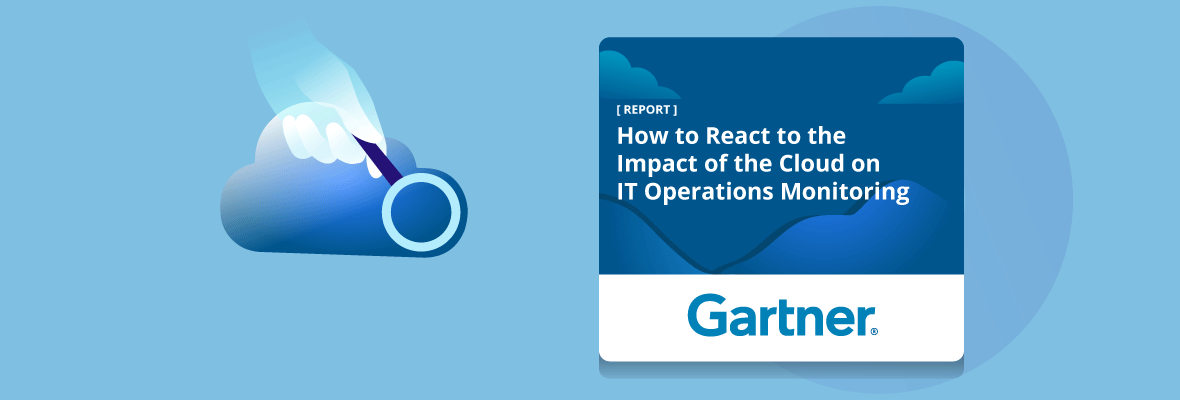Enterprise IT organizations which are not doing anything in the public cloud are becoming a rarity. A global survey conducted by O’Reilly prior to the onset of Covid-19 found that 88% of organizations are using cloud in one form or another, and public cloud dominates. Several surveys since March have shown that public cloud adoption is accelerating and with it a preference for multi-cloud computing. The Flexera 2020 State of Cloud report indicates that 93% of enterprises have a multi-cloud strategy.
As enterprises move more aggressively into cloud infrastructure and cloud-native technologies, IT infrastructure & operations (I&O) teams have fallen behind, according to research from Gartner: “How to React to the Impact of the Cloud on IT Operations Monitoring.” The authors explain: “Migration to the cloud is often driven from outside the infrastructure and operations team, which has limited input; however, it is still held accountable for service availability.”
In the report, Gartner provides the following recommendations for I&O leaders getting deeper into their cloud journey:
- Inventory the different cloud technologies in use by using the delimitations in this research, which will determine where visibility gaps will occur in specific environments.
- Eliminate visibility gaps and maintain service availability by implementing supplementary monitoring via technologies such as digital experience monitoring.
- Invest in skills for cloud monitoring by moving from siloed approaches to a holistic monitoring strategy, by performing skills assessments, and by partnering with third parties, when appropriate.
From Servers to User Journeys
The big takeaway from the Gartner report is the need to laser in on user experience over traditional technology-specific data center approaches: “I&O leaders will need to move away from their infrastructure-based monitoring approach, and move to a more end-user-focused form of visibility. This is where there must be a rethinking from traditional monitoring approaches, such as network performance monitoring and diagnostics (NPMD), application performance monitoring (APM) and ITIM, which are focused on traditional architectures, to cloud-centric monitoring.”
During Covid-19, user experience has been at the forefront of IT agendas, with so many people working from home needing high-quality digital experiences and also from changing business models. Governments, institutions and companies have transitioned in record time from physical to digital offerings which require simple, convenient and fast tools for researching, ordering and consuming products and services. These trends and requirements will likely continue well beyond a post-Covid19 world as people get accustomed to different (and often preferred) ways of working, living and purchasing.
New Mandates for Infrastructure & Operations
There are many ingredients in transitioning to cloud-based monitoring, but Lee Atchison, a cloud operations author and consultant, sums it up well. He talks about the value in developing a “culture of availability” which entails DevOps practices such as chaos testing:
“The reason most applications fail is because of success. Organizations aren’t prepared to be successful. Having more customers creates higher expectations. Rarely can you truly simulate what customers are doing. You became successful because of something that you weren’t expecting. The answer is to focus on the culture of availability. As you build systems, don't build ones that have specific limitations.”
Beyond culture, traditional infrastructure monitoring tools are not designed for the job of monitoring ephemeral cloud environments. Capabilities for synthetic monitoring and cloud-native monitoring are two of the areas noted by Gartner to succeed in running infrastructure in the cloud.
OpsRamp continues to evolve its IT infrastructure monitoring platform in tune with modern needs, as follows:
Cloud-native monitoring
- OpsRamp’s real-time cloud discovery uses a combination of API-based and agent-based techniques to provide DevOps teams a holistic view of their multi-cloud environment. OpsRamp auto-assigns cloud resources such as virtual machines, storage, networking, databases, containers, and IoT devices to service groups for better visibility and control. OpsRamp offers more than 150 integrations across Amazon Web Services, Microsoft Azure, and Google Cloud.
- OpsRamp also discovers and onboards Kubernetes clusters across on-premises, private, and multi-cloud environments so that IT teams can quickly understand the applications and services running inside their Kubernetes clusters. You can monitor what’s happening at the cluster, container, and microservices layers. DevOps teams can track resource trends (CPU and memory utilization) and the total services (nodes and containers for each cluster, a breakdown of pods by namespace) for each Kubernetes cluster. Read more about Kubenetes monitoring with OpsRamp here.
Automated discovery and monitoring of cloud resources is crucial for IT organizations to maintain high performance of popular apps and sites while still delivering new capabilities for business constituents.”
Synthetic monitoring
This is where we can get closer to the user experience, as synthetic performance monitoring focuses on user interactions with web applications. This type of monitoring creates simulated transactions to mimic how a typical user might behave and tell you if important processes, such as form submissions or loading the order page, work as expected. OpsRamp’s synthetic monitoring goes beyond simple uptime checks to modeling common user flows to explicit business outcomes.
Here are a few examples of how it works:
- IT operators can measure end-user experience and address performance issues with a broad category of synthetic transactional tests across widely used protocols such as HTTP, HTTPS, DNS, FTP, IMAP/POP3/SMTP/RTT, PING, SIP, SSL, TCP, and UDP.
- OpsRamp’s script-based recordings track user experience across multi-step, multipage transactions by measuring response time for different transaction steps and sending alerts in the event of errors.
- OpsRamp also offers synthetic checks for internal applications that are not available through public IP addresses via private location support using gateways.
- IT teams can tag a transaction-based synthetic monitor to a dashboard to view critical metrics such as uptime, downtime, response time, average latency, and alerts for their digital services.
Download the Gartner report to get more detail on how monitoring needs differ across private clouds, IaaS, PaaS and SaaS, along with some specific guidance on new skills needed in Infrastructure & Operations.



